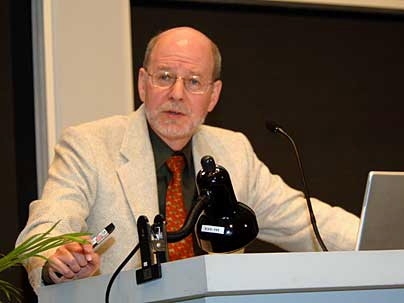When H. Robert Horvitz started studying fundamental molecular processes in the roundworm, he had no idea whether his work would ever be relevant to anything besides the obscure little organism on his lab bench.
Decades later, with a Nobel prize under his belt, Horvitz now knows his pioneering work on programmed cell death has provided new targets for possible new interventions for AIDS, cancer, autoimmune diseases and many others.
Horvitz, the David H. Koch Professor of Cancer Biology and Howard Hughes Medical Institute investigator, delivered the 35th annual Killian Award lecture April 24. Winner of the 2006-2007 James R. Killian Jr. Faculty Achievement Award, Horvitz spoke on "Worms, Life and Death: Cell Suicide in Development and Disease."
Horvitz is concerned that because of declining government support, today's young researchers will not have the same freedom he did to pursue basic research. "Basic research may lead not only to intellectually stimulating findings, but also to major insights of a practical nature," he said. "Basic research must be supported outside the private sector by governments and foundations because only such organizations can act on a basis that will benefit humanity but cannot possibly constitute a business plan."
The current downward trajectory of government funding "is positively frightening," Horvitz said. It underestimates the rate of inflation in the cost of doing biomedical research. Six to 8 percent annual increases are needed simply to maintain the current level, he said, while 10 to 12 percent increases are needed to "propel biomedical research to take advantage of current knowledge." The average 1 percent increases over the past few years have led to "an unprecedented low success rate for new projects," Horvitz said.
"Without the NIH (National Institutes of Health--the major government supporter of biomedical research), I have deep concern for the future of government-funded basic science," he said.
Horvitz has identified many genes involved in pathways of key processes that correlate directly to human development and disease. In the roundworm, there are 131 cells generated during development that are not found in the adult because they die through normal programmed cell death. Biologists used to think that only old or damaged cells died off, but researchers now know that cell death is "an active process, governed by specific genes," he said.
Cells die in many scenarios--tadpoles lose their tails as they turn into frogs, and webbing between the fingers of humans in utero is sculpted out by programmed cell death, while ducks retain their webbed feet because those cells are not killed off.
Because the process can go right, it can also go wrong. Many disorders stem from a disruption in the perfect equilibrium between cell division and programmed cell death. Some, like cancer, involve too little cell death. Some, like neurodegenerative diseases, involve too much.
The Horvitz laboratory has identified genes and proteins involved in the four-step genetic pathway of cell division and death. The human counterparts of the roundworm genes are potential therapeutic targets in a broad range of diseases. "If we could inhibit a killer gene, we could prevent the pathological process of programmed cell death and cause dying cells to survive," he said. "For diseases involving too little cell death, such as cancer, if we could activate the cell death pathway, we should be able to cause cells to die that have otherwise escaped death."
Potential therapeutics developed by a biotechnology company Horvitz founded are now in clinical trials.
Established in 1971 as a tribute to MIT's 10th president, the Killian Award recognizes extraordinary professional accomplishment by an MIT faculty member. The winner delivers a lecture in the spring term.
A version of this article appeared in MIT Tech Talk on May 2, 2007 (download PDF).





